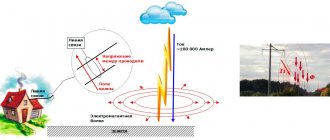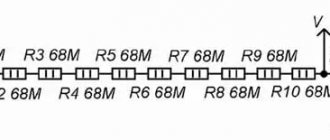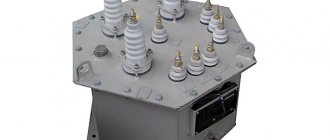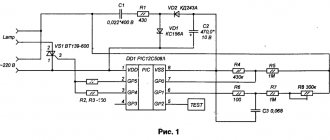Voltage sags can cause serious problems, such as disruption of production processes and loss of quality. Such failures occur much more often than interruptions. The economic consequences of voltage sags are often greatly underestimated. But what exactly is a voltage dip? How does voltage dip occur? Is it possible to prevent voltage sags or should we try to limit the possible damage through early detection? This article covers these issues in detail.
What is a voltage dip?
In accordance with the definition given in GOST 13109-97, this phenomenon means a sudden decrease in voltage amplitude followed by dynamic restoration of power within the nominal value. An example voltage drop waveform is shown below.
Voltage dip oscillogram
Why do they arise?
Voltage sags often occur due to short circuits in load nodes, where the voltage can be high, medium or up to 1000 Volts.
At the same time, they arise spontaneously; there is no regulation for this phenomenon. However, it is worth paying attention to how often they happen and what characteristics they have.
This must be done to find the correct UPS, that is, an uninterruptible power supply. This will help maintain the operation of devices that may suffer from frequent voltage surges.
Moreover, among the devices that react most sensitively to the phenomenon are servers, various computer equipment and other sensitive devices.
Permissible voltage dips according to GOST
According to GOST 32144 2013, to determine power quality indicators, failures should be classified according to two criteria:
- The magnitude of the residual stress.
- Duration.
Since the occurrence of dips is random, no numerical values have been established for the criteria presented above. However, amplitude and duration measurements should be carried out in order to create a statistical array that allows one to establish the probability of a random event for a certain power network in order to characterize the FE.
As for “failures permissible according to GOST,” this phrase does not make sense, since failure means a deviation from the norm established by GOST (0.9 Unom). To be precise, we can call normalization the permissible duration of the dip (30 s), above which the deviation is considered to be a low voltage.
Definition of the concept
Voltage reduction is a phenomenon in which at a certain point or section of the electrical network the voltage sharply decreases. After a decline, the value is restored to close, required values within a certain, short period of time, usually taking no more than 20-30 seconds.
The voltage may be at nominal values, or it may be significant when a phenomenon occurs. The relationship between these values is characterized by depth and duration, which are key parameters in characterizing this phenomenon.
The duration in dips is the time interval between the beginning and the moment when the voltage is restored to the required nominal value.
Depth values can range from ten to one hundred percent. The duration may also vary, but usually does not exceed several tens of seconds.
There is also a characteristic expressed in how often voltage decreases appear in the network. This is an auxiliary parameter, which is characterized by how many times this will happen on the network over a certain time period.
Low voltage in the network: why does this happen?
Reduced or weak load on the electrical network for a private home is not uncommon. Also, very often there is not enough power for the dacha. This fact causes a lot of inconvenience, not to mention the fact that a person cannot use the help of a washing machine.
What to do in such a situation, where to call, complain, and most importantly, how to check the quality of the power supply yourself?
Insufficient voltage in the network is an extremely unpleasant situation, but almost everyone faces it. If the lighting is poor and the light bulb only indicates its presence, then this is not a big problem.
It will be worse when washing is not possible, boiling water is impossible, there is no way to cook food on an electric stove, or the refrigerator operates intermittently.
This often happens when the network voltage is less than 180 volts. If everything works at this voltage, then this does not have a very good effect on the devices and the operation process takes a longer time.
Let us highlight several main reasons for low voltage:
- The cross-section of the cable that enters the house is incorrect;
- The switch is not connected correctly;
- The substation transformer is rebooting or has partially failed;
- The cross-section of the main line is small;
- Skewed phases.
These were the most common reasons listed. If you understand that the cause of low voltage in your home is the same as in the 1st, 2nd or 6th point, then you can correct the cause yourself.
If the other 3 reasons or one of them suits you, then you should contact service stations.
Physics of the phenomenon
First of all, it is necessary to understand that energy losses in the network are inevitable, since the load has resistance and consumes current. It is this part of the consumed electricity that heats electrical appliances. Why does the voltage drop when a load is connected? Because consumption requires a certain maximum current, and electricity is supplied by wires with different resistivities. The discrepancy between the power of the network and the diameter of the wiring or the permissible amount of power consumption is compensated by reducing the voltage.
What to do if a parameter drawdown is detected depends on the reasons for this phenomenon. Within the subscriber network in the house, low voltage can be caused by the following main reasons:
- incorrectly selected wire diameter;
- poor connection contacts;
- mismatch of network power consumption.
The presence of drives (refrigerator, washing machine, etc.) especially affects the drawdown of this parameter. The reason is that when turned on, they consume a current several times higher than the rated value. In the case of air supply of electricity, a decrease in the parameter may be caused by disturbances on the line. There are usually several consumers on one feeder, and the drop depends on any of them.
What does low voltage in the network lead to?
- — significant deterioration in starting conditions for all types of engines and engine-based devices;
- — when starting the electric motor, the starting current increases;
- — overheating of the wires up to the melting of the insulation and the possibility of fire from a short circuit;
- - reducing the brightness of the lamps or their constant blinking, which leads to discomfort in living in the house;
- — reduction in the service life of household electrical appliances;
- — unstable operation of power-sensitive devices;
- — significant deterioration in the performance of electrical appliances.
Deep landing - tension
A deep voltage drop lasting 0–3 s or more causes the synchronous motors of the compressors of the ammonia and urea shops to stop. Stopping compressors leads to interruption of technological processes for the production of ammonia and urea. [1]
During a deep voltage drop, a transformer with a capacity of 31 5 MVA, powered from the PO kV line, emergency switched off; At the same time, the flags of the gas and differential protection indicator relays fell out. [2]
When the voltage drops deeply (with a residual voltage below 20% of the rated voltage), frequency reduction relays of type IVCh-011 cease to operate (Fig. 5 - 4); therefore, preventing the incorrect operation of the first three queues of automatic frequency unloading devices can be achieved by installing a time delay element for each queue with a setting of 2 5 - 3 sec. [4]
With a deeper drop in voltage at any point in the power network, individual electric motors powered from this network may slow down and will take additional reactive power from the network, which will cause a further decrease in voltage and stop other electric motors operating even in a neighboring section of the power network. [5]
Low voltage (dip and sag)
- Connecting a powerful consumer (electric motor, compressor, etc.) to the network
- Temporary while troubleshooting other network problems
- Temporary drop in voltage amplitude. A failure differs from a sag in the duration of the problem: with a failure, the count is in sinusoidal periods (tenths of a second), and with a sag, the reduced voltage is observed for at least several seconds.
- If the voltage drops significantly, it is possible to turn off electrical equipment, restart the computer, etc.
Prevention and suppression measures:
- If possible, connect loads with high starting current via a dedicated line
- Reduced starting phenomena, for example by switching star/delta configurations
- The use of electronic devices such as inverters (frequency drives)
- In case of drawdowns, using a UPS will help
When starting the engine, the voltage drops: causes and diagnostics
Voltage drop when starting the engine is a fairly common problem, regardless of the type of power unit, as well as the make, model or class of the car. The voltage drop often manifests itself in such a way that at the moment the starter begins to rotate, the headlights sharply dim or go out, the dashboard lights lose their brightness, the radio turns off and restarts, etc.
A voltage drop can occur both when trying to start a cold internal combustion engine, and when starting an already warmed-up unit. As for the start itself, in some cases the starter actively turns for the first couple of seconds, then a certain “stutter” occurs. At this moment, the voltage drops, while the crankshaft continues to turn, but with great difficulty, but a serviceable engine usually starts.
There can be several reasons for such a malfunction, both obvious and easily removable, and hidden. In this article we will talk about why the voltage drops when starting the engine, as well as how to detect and fix the problem.
Low voltage when starting the engine: how to find the cause
Let's start with the fact that the battery is not always the culprit of all troubles, although quite often reduced voltage occurs as a result of problems with the battery. In any case, before you start diagnosing a car regarding electrical parts, you must have a special auto tester (multimeter).
It is important that the device accurately measures certain parameters. As a rule, the functionality of the device should allow you to measure voltage, resistance, and current. At the same time, when troubleshooting voltage-related problems, you also need to take into account the crankshaft speed.
Checking the car battery
So, when diagnosing, you need to start by checking the battery, as well as the car generator. The condition of the battery is assessed by connecting the tester to the battery terminals. Normally, the voltage on the battery, taking into account the absence of load (all consumers are turned off), should be at least 12.6 V. A decrease in this indicator means that there is a partial undercharge or problems have arisen with the battery itself (sulfation of the plates, boiling off of the electrolyte, etc.).
One way or another, a discharged battery will not be able to quickly turn the starter and at the same time maintain the required voltage in the on-board network. As a result, the starter will turn slowly and the engine will be difficult to start. The battery capacity can also be assessed using a load fork. This plug makes it possible to implement resistance when connecting to the battery terminals.
You can also measure the voltage with a voltmeter, turning on the side lights and high beam headlights for the load. Typically, the discharge current under such a load (taking into account the installed halogen incandescent lamps) is about 5–6 A, and the voltage is about 11.5 V. If this is the case, then the battery is working and the problem needs to be looked for further.
Quick starter diagnostics
If we talk about the voltage directly at the moment of starting (when the starter turns), the voltage at the battery terminals should not fall below 9.5 V. In cases where this happens on a working and charged battery, it can be argued that a starter malfunction has occurred. In other words, the starter requires too much electrical energy when operating, which should not normally be the case.
It is important to understand that over time, various elements of the starter wear out, as well as oxidation of its contacts, deterioration of brushes, etc. As a result, the device requires a very high starting current for normal operation, which a standard battery is simply unable to provide.
Let us add that to measure the current you need an ammeter, which is connected to the gap. At the same time, it is highly not recommended to break the circuit in a car; also, not all ammeters are able to work correctly and record high readings that occur when the internal combustion engine is started.
For this reason, it is better to have a special motor tester for such tasks. The main advantage of the device is that the measurement accuracy is quite high, and there is no need to connect the tester to the break, since the device has separate sensors. These sensors are overhead and work even through wire insulation. These elements are capable of effectively recording changes in magnetic field strength when a current of one or another magnitude passes through the wires in the circuit.
Increased voltage (surge, overvoltage)
- High Impedance Grounding Schemes
- Disabling a powerful consumer
- Phase breakdown in a three-phase network
- Uneven electricity consumption
- Temporary increase in voltage amplitude. A surge differs from an overvoltage in duration: a surge, similar to a dip, is a shorter fault (tenths of a second), and an overvoltage, similar to a sag, lasts at least several seconds.
- Data errors
- Flickering lighting
- Wear of electrical contacts and insulation
- Damage to semiconductor devices
- Increase in current strength and, as a result, tripping of circuit breakers
Prevention and suppression measures:
- The best protection is to use a UPS
The impact of failures on the operation of electrical equipment
This phenomenon is considered less dangerous deviations in frequency and voltage pulses, but, nevertheless, dips can lead to the following consequences:
- Reducing the intensity of the luminous flux produced by sources with a filament.
- Reduced sensitivity of radio and television receivers.
- Instability of X-ray installations.
- False alarms of electronic control systems.
- A decrease in the level of direct current in the contact network of electric transport has a negative impact on the operation of rolling stock.
- Changing the characteristics of voltage converters.
- A decrease in the power of electric motors, which leads to electrical losses and wear.
A failure depth of more than 10% of the permissible deviation will most likely cause the gas-discharge lighting sources to turn off. At low voltage, more than 15% of the permissible norm, the starters will open, which will cause a shutdown of electrical equipment and, as a result, lead to disruption of the technical process.
It is characteristic that dips do not have a serious impact on electric arc welding due to the large thermal inertia of the process, while the quality of spot welding is significantly reduced.
Low voltage in the network: what to do, how to raise it, reasons
Without electricity today it’s like being without hands. It “gives life” to dozens of household appliances and lighting. The standard voltage in the network is 220 volts. Most electrical and lighting devices work with this. Sometimes the voltage suddenly drops by 40-60 volts.
This network state is considered critical, low. The wiring stops working properly. There is low voltage in the network, what to do, how to increase it? First of all, determine who the problem is coming from: the electricity supplier or consumer.
In the first case, collective letters and complaints will help, in the second - urgent and competent measures.
Possible consequences of power surges
Voltage changes that go beyond the limits established by the standards threaten electricity consumers with failure of electrical appliances. Let us recall that at 220 volts the lower maximum permissible limit is 198.0 V, the upper is 242 V.
The greatest danger to household electrical appliances is lightning surges, since the magnitude of the pulse can reach several kilovolts. Below is the power supply of a 40” TV after a lightning strike hit the overhead line from which a private house was powered. Neither the voltage relay installed at the input, nor the internal protection and fuses of the electronic device had time to operate.
TV power supply after lightning strikes power lines
With a high probability, household appliances will “burn out” if the overvoltage is caused by a zero break. In such cases, the voltage begins to tend to 380.0 V (in practice, it is usually 300-320 V, but this is enough for the devices to fail).
Surges of lower levels cause malfunctions of electronic equipment and also shorten the life of equipment equipped with compressors or electric motors. Minor differences and surges have practically no serious impact on electric heating devices, with the exception of equipment with an electronic control system.
Excessive load on the power grid
Many electricity consumers, when connected to the network, create a large load on it. Such electrical appliances include, for example, high-power electric motors. Such motors use much higher currents for starting than the rated ones, and if the wiring is designed exclusively for currents for operation in the rated mode, failures will occur during startup.
This phenomenon is actually related directly to the network reserve, as well as to the resistance at the point of common connection and correct compliance with the parameters of the connecting wiring.
Voltage losses caused in this way usually last longer than, for example, faults caused by faults in distribution networks and can last from 1 to 10 seconds.
There are known ways to solve problems with devices associated with wiring resistance. Devices with high power consumption can be connected to the mains through connections at common points or through a special additional transformer coil.
Methods of protection against power surges
Since the possibility of pulse surges, overvoltages or other types of deviations from the normal network voltage cannot be completely eliminated, it is necessary to find a way to protect expensive equipment. There is no need to “reinvent the wheel” since there are ready-made solutions. Let's briefly talk about each of them.
The problem of overvoltage or sag can be solved by installing a special voltage relay. This protective device (not to be confused with an electronic RCD) cuts off the power if the input voltage is outside the specified range.
Voltage relay SR-721M
Power restoration occurs after the situation normalizes. These devices provide protection if the neutral wire breaks or the contact line of a city electric transport gets onto the power line wires. Against pulse surges that occur during a nearby lightning discharge, voltage relays are practically useless.
It should be taken into account that during a protective shutdown, the mains voltage disappears; in order not to wait in the dark until the power supply stabilizes, it is recommended to acquire a source with an uninterruptible power supply. Let's talk about the features of this solution.
In fact, these devices are not protective equipment, but are used in conjunction with them to provide emergency power supply. Providing uninterrupted power to the entire house is not practical as it would be a very expensive solution. But you can power a section of electrical wiring, for example, a lighting line.
Household UPS Makelsan
When choosing a UPS, it is necessary to take into account the total power of electrical appliances that will be powered from it, and based on this, select a device with the appropriate maximum current. You can learn more about choosing a UPS from the materials on our website.
If the quality of electricity is poor (surges, surges, etc.), it is recommended to use special voltage stabilizers. These devices are especially effective when the power supply “sags” at the input.
Model range of Cascade stabilizers
Stabilizers cope well with impulse noise, but are ineffective against high levels of overvoltage, so they are recommended to be used in conjunction with voltage relays.
In this case, only surge suppressors can provide reliable protection. For private houses powered by overhead lines, installation of an arrester is necessary; otherwise, during a thunderstorm, all electrical appliances should be disconnected from the sockets.
are effective only as protection against high-voltage surges; in other cases they are useless.
As you can see, there is no perfect protection, so you need to settle on a comprehensive solution.
How much damage can horse racing cause?
An electrical network whose voltage constantly fluctuates poses a threat to household appliances. And since household appliances are very expensive, the issue of protecting them from sudden changes is very relevant today. If the electrical network is of poor quality, then the voltage can reach 380 V, and drop to 180 V. This is when the norm is 220 V with a permissible error of 10%.
But such permissible deviations can cause a lot of trouble in people's lives. Maybe for household appliances this only entails a reduction in service life, but for such devices where accurate values are important, this is already a big problem. For example, this could be laboratory or any medical equipment, various production equipment. Power surges cause serious damage.










